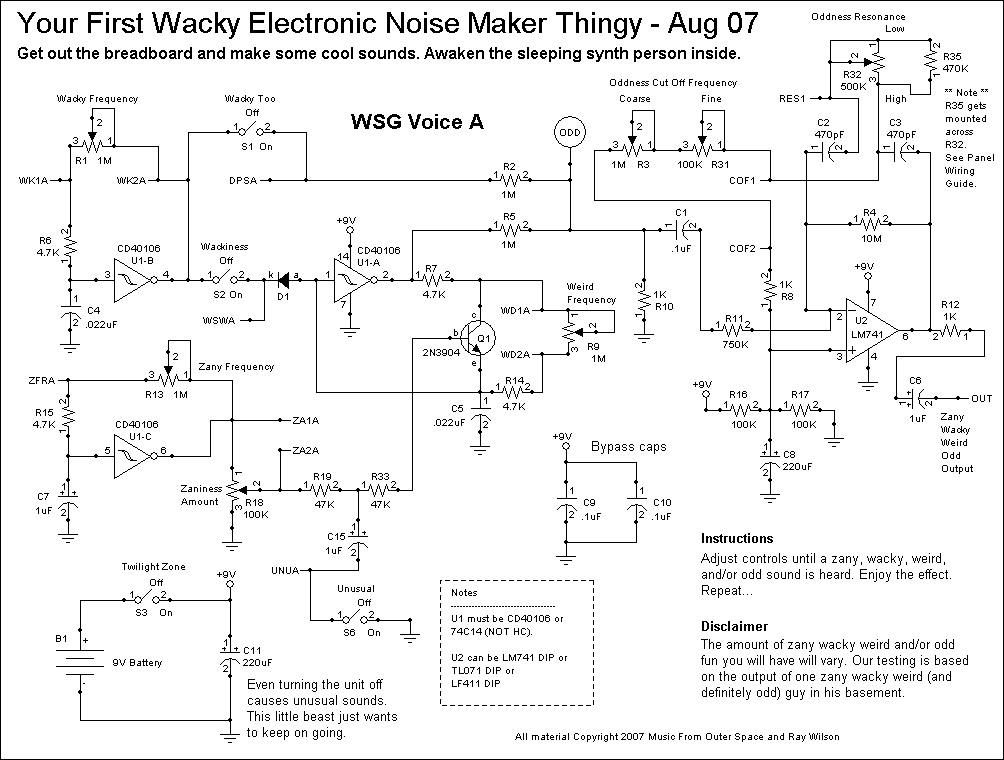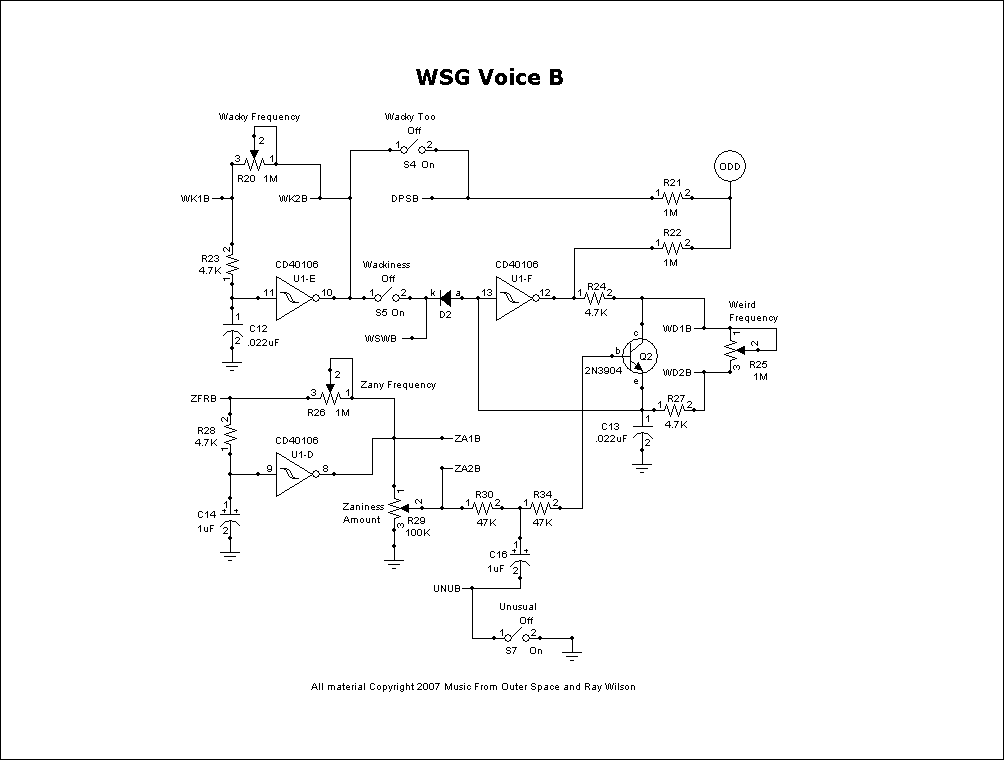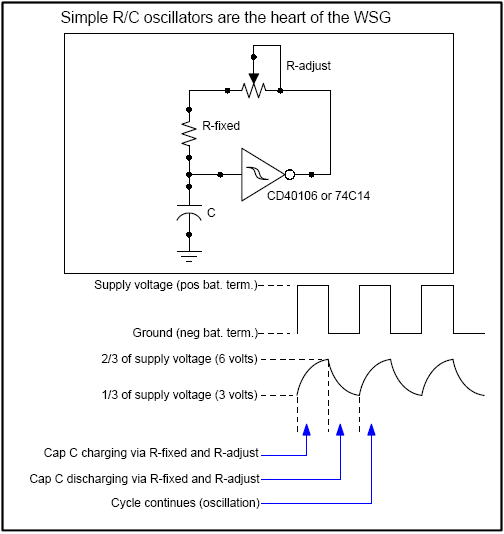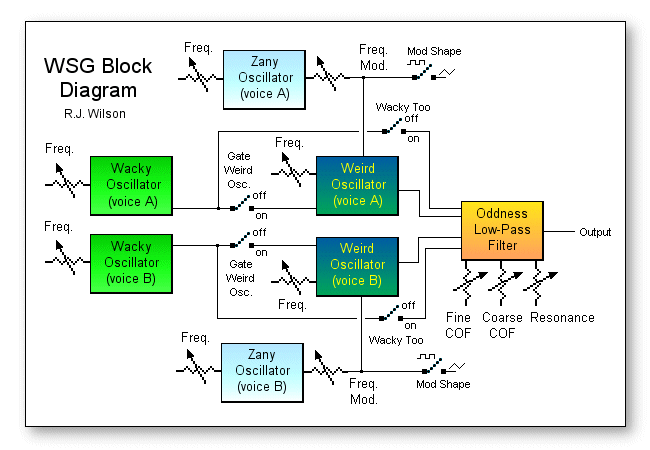Ray Wilson authored this content while he was actively running MFOS as the founder and resident genius.
We retain the content because it reflects a valuable point of view representing that time and place.
Article by Ray Wilson
|
The Weird Sound Generator uses technology found at the crash site known today as Area 52 (Anything else is soooo Area 51).
The Weird Sound Generator focuses the latent energy of the universe into unusual sounds and lets you hear them for yourself.
On a more serioue note the output voltage of the WSG is about 600 to 700 millivolts but can peak as high as 1.5V when the
oscillators and filter are resonant. The current drawn averages 4 to 6 milliamps but can peak at about 7.6 milliamps.
To put it in layman's terms... U1B, R6, R1, and C4 form an oscillator because inverting schmitt trigger U1-B just sits there charging and discharging C4 because when C4 charges up to 2/3 of the supply the output of U1-B goes low and starts to discharge C4 via R6 and R1 ("Wacky Frequency" pot). Then when it gets to 1/3 the supply voltage the output of U1-B goes high and starts charging C4 again and that just keeps happening again and again and again... it's an oscillator (it oscillates... goes up and down). The whole upshot is that U1-B's output goes between logic 1 and logic 0 at a rate set by R1 ("Wacky Frequency"). The rate is audible to us because it's in the audio range. When R1 is adjusted so that there is less resistance between points WK1A and WK2A the oscillator goes faster (higher) and visa versa. U1-C (along with R15 and R13) is used in the same way only the timing capacitor is much larger and thus the charge and discharge times are longer. It produces the "Zany Frequency". The output of U1-C is a lower frequency square wave. It's output is used to modulate the frequency of the oscillator made up of U1-A, R7, R14, Q1, and R9 (the "Weird" oscillator). Notice that Q1 is shunting (in parallel with) R9 the frequency control for the "Weird Frequency". When current flows through R19 and R33 during the high periods of U1-C's oscillation it turns Q1 on a bit (depending on the setting of R18 "Zaniness Amount") so that during the high periods of U1-C's oscillation the frequency of U1-A's oscillation goes up. During the low periods of U1-C's oscillation the frequency of U1-A's oscillation goes back down (to the frequency set by R9). So you can get that dee doh dee doh type of thing going. Turn the "Zany Frequency" high enough (and the "Zaniness" control up) and you get a kind of bell tone from the oscillator formed by U1-A and associated components. U1-B and associated components (the "Wacky" oscillator) serves two purposes. It can be added to the audio output via turning the "Wacky Too" switch to on. In this mode both the "Weird" oscillator (U1-A and associated components) and the "Wacky" oscillator (U1-B and associated components) are applied to the input of the filter. You can get some nice beating (tuned close together) or chord (tuned to 4th or 5th) effects like that. The other purpose of the "Wacky" oscillator is to gate the "Weird" oscillator on an off. When the "Wackiness" switch is On the input of U1-A is brought low during the low part of U1-B's oscillations (via D1). During that time U1-A cannot oscillate. But during the high portions of the "Wacky" oscillator's output D1 is reverse biased and so the input to U1-A ignores U1-B for while. U1-B does not like being ignored but it gets over it pretty fast. The therapy seems to be working. By adjusting the "Wacky Frequency" lower that the Weird frequency and turning Wackiness on you can get a hollow sounding sync effect from U1-A. The "Unusual" control, when On, causes the signal appearing at the base of Q1 to be integrated (turned into a triangle like wave) so that the Weird frequency goes up and down but glides from high to low instead of stepping as it does when the Unusual switch is Off. This is because when the negative side of electrolytic cap C15 is grounded it takes a bit of time to charge and discharge it via R19. When it's negative side is disconnected from ground it's like it's not even there and U1-C's square wave just plows on through. The filter is an adjustable low pass with a lot of Q (emphasis of the pass band). The Q can be turned down slightly with the "Oddness Resonance" control. The "Coarse" and "Fine Oddness Cut Off Frequency" controls set the cut off frequency of the filter. When you sweep the filter up you get a kind of wah effect. It is very ringy on purpose to add a lot of harmonic character to the sound. You can Turn the ringiness down with the "Oddness Resonance" control. The "Fine" control is so you can play with the harmonics over a smaller range with more precision. |
MFOS Weird Sound Generator Page 1 PDF

| The astute observer has already noted that page two is pretty much the same as the corresponding parts of Page one... sooooo that's that. |
MFOS Weird Sound Generator Page 2 PDF

| Now as I was saying the universal energy that is just flying around wildly during the normal operation of the universe is captured whenever a MFOS Weird Sound Generator is present. The universal energy waves flow into the WSG and then into your brain as you perceive them as sound waves by adjusting the knobs of the WSG. Einstein's theories are rife with information pertaining to weird sounds but I digress. Make one and have fun with it which is positively the lowest part of the bottom line. And don't forget to expose your fetus to the weird sounds and turn them into a genius or a prodigy (or an Einstein if you will). To do anything less would be irresponsible. |
The Heart Of The WSG. A Simple "Feedback Around A Schmitt Trigger" Oscillator.
The heart of the WSG is this simple oscillator which is actually in the WSG six times in various forms.
When power is first applied to the circuit the capacitor C is in a low state and charges from 0 to 2/3 of the supply (with a 9 volt battery this is 6 volts) at a rate determined by (A) the size of the capacitor and (B) the resistance of R-fixed and the setting of R-adjust. When C charges to 2/3 of the supply voltage the output of the CD40106 snaps from it's current high state (9V) to low (0V). The whole idea of a schmitt trigger is to snap high or low depending on the input voltage. Since this is an inverting schmitt trigger it snaps low when the input exceeds it's high input threshold and low when the input goes below it's low input threshold. Now that the CD40106's output has snapped low, capacitor C discharges at the same rate it charged before to 1/3 the supply voltage (the low threshold) at which time the output of the CD40106 inverting schmitt trigger snaps high again. This cycle continues to repeat and thus we have oscillation.
We use the oscillators in the WSG for sound generation and for modulcation sources. When R-adjust is set to place high resistance between the output of the CD40106 and the capacitor the rate of charge and discharge is low and thus the frequency of oscillation is low. When R-adjust is set to place low resistance between the output of the CD40106 and the capacitor the rate of charge and discharge is high and hence the frequency of oscillation is high.

